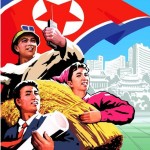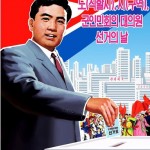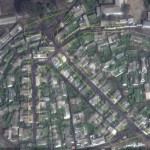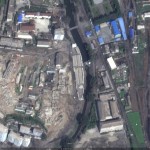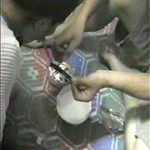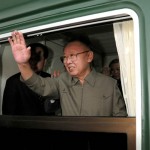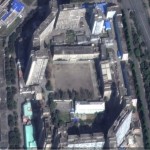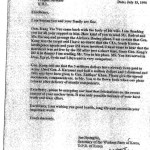The founder of Pakistan’s nuclear bomb program asserts that the government of North Korea bribed top military officials in Islamabad to obtain access to sensitive nuclear technology in the late 1990s.
Abdul Qadeer Khan has made available documents that he says support his claim that he personally transferred more than $3 million in payments by North Korea to senior officers in the Pakistani military, which he says subsequently approved his sharing of technical know-how and equipment with North Korean scientists.
Khan also has released what he says is a copy of a North Korean official’s 1998 letter to him, written in English, that spells out details of the clandestine deal.
Some Western intelligence officials and other experts have said that they think the letter is authentic and that it offers confirmation of a transaction they have long suspected but could never prove. Pakistani officials, including those named as recipients of the cash, have called the letter a fake. Khan, whom some in his country have hailed as a national hero, is at odds with many Pakistani officials, who have said he acted alone in selling nuclear secrets.
Nevertheless, if the letter is genuine, it would reveal a remarkable instance of corruption related to nuclear weapons. U.S. officials have worried for decades about the potential involvement of elements of Pakistan’s military in illicit nuclear proliferation, partly because terrorist groups in the region and governments of other countries are eager to acquire an atomic bomb or the capacity to build one.
Because the transactions in this episode would be directly known only to the participants, the assertions by Khan and the details in the letter could not be independently verified by The Washington Post. A previously undisclosed U.S. investigation of the corruption at the heart of the allegations — conducted before the letter became available — ended inconclusively six years ago, in part because the Pakistani government has barred official Western contact with Khan, U.S. officials said.
By all accounts, Pakistan’s confirmed shipments of centrifuges and sophisticated drawings helped North Korea develop the capacity to undertake a uranium-based route to making the bomb, in addition to its existing plutonium weapons. Late last year, North Korea let a group of U.S. experts see a uranium-enrichment facility and said it was operational.
The letter Khan released, which U.S. officials said they had not seen previously, is dated July 15, 1998, and marked “Secret.” “The 3 millions dollars have already been paid” to one Pakistani military official and “half a million dollars” and some jewelry had been given to a second official, says the letter, which carries the apparent signature of North Korean Workers’ Party Secretary Jon Byong Ho. The text also says: “Please give the agreed documents, components, etc. to . . . [a North Korean Embassy official in Pakistan] to be flown back when our plane returns after delivery of missile components.”
The North Korean government did not respond to requests for comment about the letter.
Jehangir Karamat, a former Pakistani military chief named as the recipient of the $3 million payment, said the letter is untrue. In an e-mail from Lahore, Karamat said that Khan, as part of his defense against allegations of personal responsibility for illicit nuclear proliferation, had tried “to shift blame on others.” Karamat said the letter’s allegations were “malicious with no truth in them whatsoever.”
The other official named in the letter, retired Lt. Gen. Zulfiqar Khan, called it “a fabrication.”
The Pakistani Embassy in Washington declined to comment officially. But a senior Pakistani official, who spoke on the condition of anonymity “to avoid offending” Khan’s supporters, said the letter “is clearly a fabrication. It is not on any official letterhead and bears no seal. . . . The reference to alleged payment and gifts to senior Pakistani military officers is ludicrous.”
There is, however, a Pakistani-Western divide on the letter, which was provided to The Post by former British journalist Simon Henderson, who The Post verified had obtained it from Khan. A U.S. intelligence official who tracks nuclear proliferation issues said it contains accurate details of sensitive matters known only to a handful of people in Pakistan, North Korea and the United States.
A senior U.S. official said separately that government experts concluded after examining a copy of the letter that the signature appears authentic and that the substance is “consistent with our knowledge” now of the same events. Both officials spoke on the condition of anonymity because of the diplomatic sensitivity of the allegation.
Olli Heinonen, a 27-year veteran of the International Atomic Energy Agency who led its investigation of Khan before moving to Harvard’s Kennedy School last year, said the letter is similar to other North Korean notes that he had seen or received. They typically lacked a letterhead, he said; moreover, he said he has previously heard similar accounts — originating from senior Pakistanis — of clandestine payments by North Korea to Pakistani military officials and government advisers.
The substance of the letter, Heinonen said, “makes a lot of sense,” given what is now known about the North Korean program.
Jon, now 84, the North Korean official whose signature appears on the letter, has long been a powerful member of North Korea’s national defense commission, in charge of military procurement. In August, the U.S. Treasury Department imposed financial sanctions on his department for its ballistic missile work.
According to Khan, in the 1990s, Jon met then-Pakistani President Farooq Leghari, toured the country’s nuclear laboratory and arranged for dozens of North Korean technicians to work there. Khan detailed the payments Jon allegedly arranged in written statements that Henderson, a senior fellow at the Washington Institute for Near East Policy, shared with The Post. Henderson said he acquired the letter and the statements from Khan in the years after his 2004 arrest by Pakistani authorities.
Henderson, who has written extensively about Khan, said he provided the letter to The Post because he lacked the resources to authenticate it himself.
He said the letter and the statements constitute new evidence that Khan’s proliferation involved more-senior Pakistani officials than Khan himself. Khan has been freed from home detention but remains under round-the-clock surveillance in a suburb of Islamabad, where the government has recently threatened him with new sanctions for illicit communications.
Some of Khan’s past statements have been called into question. Pakistani officials have publicly accused Khan — who is still highly regarded by many in his country — of exaggerating the extent of official approval he received for his nuclear-related exports to North Korea, Libya and Iran. In 2006, then-Pakistani President Pervez Musharraf accused Khan of profiting directly from nuclear-related commerce.
Although Khan “was not the only one who profited from the sale of Pakistan’s nuclear weapons technology and components . . . by Pakistani standards, his standard of living was lavish,” and the disclosure of his private bank account in Dubai, the United Arab Emirates — with millions of dollars in it — was highly suspicious, said Mark Fitzpatrick, an acting deputy assistant secretary of state for nonproliferation during the George W. Bush administration.
Khan says the bank account was used by associates and a charity he founded, and the Pakistani government never asked him to return any money. He said that in 2007 — six years after his formal retirement and complaints of financial hardship — Musharraf arranged for a lump-sum payment equivalent to $50,000 and a monthly pension of roughly $2,500, which Khan says “belied all those accusations and claims.”
Although U.S. officials disagreed for years about North Korea’s uranium-enrichment capability, the dispute was settled in November when the Pyongyang government invited Siegfried Hecker — a metallurgist who formerly directed a U.S. nuclear weapons laboratory — to see a newly renovated building at Yongbyon that housed more than 1,000 enrichment centrifuges.
Hecker said in an interview that although the government did not disclose their origins, their size, shape and stated efficiency were close to a centrifuge model, known as the P2, that Khan obtained illicitly from Europe. Khan has said that he helped give North Korea four such devices.
“The combination of the Pakistani design, the Pakistani training and the major [Pakistani] procurement network they had access to” allowed North Korea to “put the pieces together to make it work,” Hecker said.
According to Khan’s written account, the swap of North Korean cash for sensitive Pakistani technology arose during a squabble in 1996 over delays in Pakistan’s payment to North Korea for some medium-range missiles. U.S. officials said they had heard of this dispute.
In the letter, Jon first thanks Khan for his assistance to North Korea’s then-representative to Islamabad, Gen. Kang Tae Yun, in the aftermath of a bizarre shooting incident in which an assailant supposedly gunning for Kang accidentally killed his wife. But the heart of the letter concerns two key transactions: the provision of a kickback to speed the overdue Pakistani missile-related payments and additional payments for the nuclear-related materials.
Khan, in his written statements — including an 11-page narrative he prepared for Pakistani investigators while under house arrest in 2004 that was obtained by The Post — said the idea for the kickback came from a Pakistani military officer.
Khan said Kang responded by delivering a half-million dollars in cash in a suitcase to a top Pakistani general, who declined it. Khan said Karamat, a more senior officer at the time, then said: “I should arrange with Gen. Kang to pay this money to him for some secret [Pakistani] army funds. He would then sanction the payment of their outstanding charges.”
“I talked to Gen. Kang, and he gave me the $0.5 million in cash, which I personally delivered” to Karamat, Khan wrote. He says this payment only whetted the army’s appetite, however: Karamat, who had just become chief of the army staff, “said to me that he needed more money for the same secret funds and that I should talk to Gen. Kang.”
Kang then started bargaining, saying that his superiors “were willing to provide another $2.5 million, provided we helped them with the enrichment technology,” Khan wrote.
Once the details of that assistance were worked out, Khan wrote, “I personally gave the remaining $2.5 million to Gen. Karamat in cash at the Army House to make up the whole amount.” Khan said he transferred all the funds on two occasions in a small canvas bag and three cartons, in one case at the chief of army staff’s official residence.
On the top of one carton was some fruit, and below it was $500,000 in cash, Khan wrote in a narrative for Henderson. Inside the bag was $500,000, and each of the other two cartons held $1 million, Khan wrote.
If the account is correct, the ultimate destination of the funds in any event remains unclear. Pakistani officials said in interviews that they found no trace of the money in Karamat’s accounts after an investigation. But the military is known to have used secret accounts for various purposes, including clandestine operations against neighboring India in the disputed Kashmir region.
Karamat said that such a delivery would have been impossible and that he “was not in the loop to delay, withhold or sanction payments” to North Korea. He called the letter “quite mind-boggling.”
The letter also states that Zulfiqar Khan, Karamat’s colleague, received “half a million dollars and 3 diamond and ruby sets” to pave the way for nuclear-weapons-related transfers. Zulfiqar Khan, who later became the head of Pakistan’s national water and power company, was among those who had witnessed the country’s nuclear weapons test six weeks before the letter was written.
Asked to respond, he said in an e-mail that he considered the entire episode “a fabrication and figment of imagination,” and he noted that he had not been accused of “any sort of dishonesty or irregularity” during 37 years as a military officer. He denied having any connection to North Korean contracts.
The senior Pakistani official said that Karamat and Zulfiqar Khan were “amongst the first to initiate accountability” for Abdul Qadeer Khan and his colleagues, and that implicating them in illegal proliferation “can only be deemed as the vengeful reaction of a discredited individual.”
In the letter, Jon requests that “the agreed documents, components” be placed aboard a North Korean plane. He goes on to congratulate Khan on Pakistan’s successful nuclear test that year and wish him “good health, long life and success in your important work.”
The Pakistani intelligence service interrogated Karamat in 2004 about Khan’s allegations, according to a Pakistani government official, but made no public statement about what it learned. Musharraf, who oversaw that probe, appointed Karamat as ambassador to Washington 10 months later, prompting further scrutiny by the U.S. intelligence community of reports that Karamat had arranged the sale of nuclear gear for cash.
Those inquiries, several U.S. officials said, ended inconclusively at the time because of Karamat’s denial and Washington’s inability to question Khan.
For those of you who are interested, here is the biography of Jon Byong-ho from the Yonhap North Korea Handbook (p. 796):
